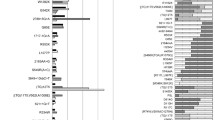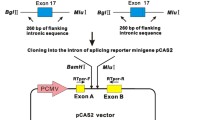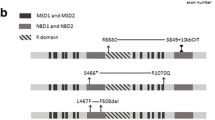Abstract
The alternatively spliced exon 9 of the cystic fibrosis transmembrane conductance regulator (CFTR) gene codes for the initial part of the amino-terminal nucleotide-binding fold of CFTR. A unique feature of the acceptor splice site preceding this exon is a variable length polymorphism within the polypyrimidine tract influencing the extent of exon 9 skipping in CFTR mRNA. We investigated this repeat for its relationship to CFTR mutations and intragenic markers on 200 chromosomes from German patients with cystic fibrosis (CF). Four frequent length variations were strongly associated with the four predominant haplotypes previously defined by intragenic marker dimorphisms. One of these alleles displayed absolute linkage disequilibrium to the major CF mutation ΔF508. Other frequent CFTR mutations were linked to one particular splice site haplotype indicating that differential exon 9 skipping contributes little to the clinical heterogeneity among CF patients with an identical mutation. We also identified a novel missense mutation (V456F) and a novel nonsense mutation (Q414X) within the coding region of exon 9. The missense mutation V456F adjacent to Walker motif A was present in a pancreas-sufficient CF patient. In contrast, the pancreas-insufficient Q414X/ΔF508 compound heterozygote suffered from a severe form of the disease, indicating that alternative splicing of exon 9 does not overcome the deleterious effect of a stop codon within this exon.
Similar content being viewed by others
References
Ames GF, Lecar H (1992) ATP-dependent bacterial transporters and cystic fibrosis: analogy between channels and transporters. FASEB 16:2660–2666
Anderson MP, Welsh MJ (1992) Regulation by ATP and ADP of CFTR chloride channels that contain mutant nucleotide binding domains. Science 257:1701–1704
Augarten A, Kerem BS, Yahav Y, Noiman S, Rivlin Y, Tal A, Blau H, Ben-Tur L, Szeinberg A, Kerem E, Gazit E (1993) Mild cystic fibrosis and normal or borderline sweat tests in patients with the 3849 + 10 kB C→T mutation. Lancet 342:25–26
Baserga S, Benz EJ (1988) Nonsense mutations in the human β-globin gene affect mRNA metabolism. Proc Natl Acad Sci USA 85:2056–2060
Boat TF, Welsh MJ, Beaudet AL (1989) Cystic fibrosis. In: Scriver CR, Beaudet AL, Sly WS, Valle D (eds) The metabolic basis of inherited disease, 6th edn. McGraw-Hill, New York, pp 2649–2680
Bremer S, Hoof T, Wilke M, Busche R, Scholte B, Riordan JR, Maass G, Tümmler B (1992) Quantitative expression patterns of multidrug-resistance P-glycoprotein (MDR1) and differentially spliced cystic-fibrosis transmembrane-conductance regulator mRNA transcripts in human epithelia. Eur J Biochem 206:137–149
Chang XB, Tabcharani JA, Hou YX, Jensen TJ, Kartner N, Alon N, Hanrahan JW, Riordan JR (1993) Protein kinase A (PKA) still activates CFTR chloride channel after mutagenesis of all 10 PKA consensus phosphorylation sites. J Biol Chem 268:11304–11311
Chu CS, Trapnell BC, Murtagh Jr JJ, Moss J, Dalemans W, Jallat S, Mercenier A, Pavirani A, Lecocq JP, Cutting GR, Guggino WB, Crystal RG (1991) Variable deletion of exon 9 coding sequences in cystic fibrosis transmembrane conductance regulator gene mRNA transcripts in normal bronchial epithelium. EMBO J 10:1355–1363
Chu CS, Trapnell BC, Curristin SM, Cutting JR, Crystal RG (1992) Extensive posttranscriptional deletion of the coding sequences for part of nucleotide binding fold 1 in respiratory epithelial mRNA transcripts of the cystic fibrosis transmembrane conductance regulator gene is not associated with the clinical manifestations of cystic fibrosis. J Clin Invest 90:785–790
Chu CS, Trapnell BC, Curristin S, Cutting GR, Crystal RG (1993) Genetic basis of variable exon 9 skipping in cystic fibrosis transmembrane conductance regulator mRNA. Nature Genet 3:151–156
Cremonesi L, Ferrari M, Belloni E, Magnani C, Seia M, Ronchetto P, Rady M, Russo MP, Romeo G, Devoto M (1992) Four new mutations of the CFTR gene (541delC, R347H, R352Q, E585X) detected by DGGE analysis in Italian patients, associated with different clinical phenotypes. Hum Mutat 1:314–319
Cuppens H, Marynen P, De Boeck C, De Baets F, Eggermont E, Van den Berghe H, Cassiman JJ (1990) A child, homozygous for a stop codon in exon 11, shows milder cystic fibrosis symptoms than her heterozygous nephew. J Med Genet 27:717–719
Cutting GR, Curristin SM, Nash E, Rosenstein BJ, Lerer I, Abeliovich D, Hill A, Graham C (1992) Analysis of four diverse population groups indicate that a subset of cystic fibrosis mutations occur in common among Caucasians. Am J Hum Genet 50:1184–1195
Dietz HC, Valle D, Francomano CA, Kendzior Jr RJ, Pyeritz RE, Cutting GR (1993) The skipping of constitutive exons in vivo induced by nonsense mutations. Science 259:680–683
Dörk T, Neumann T, Wulbrand U, Wulf B, Kälin N, Maass G, Krawczak M, Guillermit H, Ferec C, Horn G, Klinger K, Kerem BS, Zielenski J, Tsui L-C, Tümmler B (1992) Intra-and extragenic marker haplotypes of CFTR mutations in cystic fibrosis families. Hum Genet 88:417–425
Dörk T, Kälin N, Stuhrmann M, Schmidtke J, Tümmler B (1992) A termination mutation (2143delT) in the CFTR gene of German cystic fibrosis patients. Hum Genet 90:279–284
Dörk T, Wulbrand U, Tümmler B (1993) Four novel cystic fibrosis mutations in splice junction sequences affecting the CFTR nucleotide binding folds. Genomics 15:688–691
Dörk T, Fislage R, Rappen U, Tümmler B (1993) Severe splice site mutation preceding exon 9 of the CFTR gene. Hum Mol Genet 2:1313–1314
Gasparini P, Nunes V, Savoia A, Dognini M, Morral N, Gaona A, Bonizzato A, Chillon M, Sangiulo F, Novelli G, Dallapiccola B, Pignatti PF, Estivill X (1991) The search for south European cystic fibrosis mutations: identification of two new mutations, four variants and intronic sequences. Genomics 10:193–200
Gross-Bellard M, Dudet P, Chambon P (1973) Isolation of high-molecular-weight DNA from mammalian cells. Eur J Biochem 36:32–38
Gyllenstein UB, Erlich HA (1988) Generation of single-stranded DNA by the polymerase chain reaction and its application to direct sequencing of the HLA DQA locus. Proc Natl Acad Sci USA 85:7652–7656
Hamosh A, Trapnell BC, Zeitlin PL, Montrose-Rafizadeh C, Rosenstein BJ, Crystal RG, Cutting GR (1991) Severe deficiency of cystic fibrosis transmembrane conductance regulator messenger RNA carrying nonsense mutations R553X and W1316X in respiratory cells of patients with cystic fibrosis. J Clin Invest 88:1880–1885
Hamosh A, Rosenstein BJ, Cutting GR (1992) CFTR nonsense mutations G542X and W1282X associated with severe reduction of CFTR mRNA in nasal epithelial cells. Hum Mol Genet 1:542–544
Heng HHQ, Shi XM, Tsui LC (1993) Fluorescence in situ hybridization mapping of the cystic fibrosis transmembrane conductance regulator (CFTR) gene to 7q31.3. Cytogenet Cell Genet 62:108–109
Higgins CF (1992) ABC transporters: from microorganisms to man. Annu Rev Cell Biol 8:67–113
Johnson LG, Olsen JC, Sarkadi B, Moore KL, Swanstrom R, Boucher RC (1992) Efficiency of gene transfer for restoration of normal airway epithelial function in cystic fibrosis. Nature Genet 2:21–25
Kerem BS, Rommens JM, Buchanan JA, Markiewicz D, Cox TK, Chakravarti A, Buchwald M, Tsui L-C (1989) Identification of the cystic fibrosis gene: genetic analysis. Science 245:1073–1080
Kerem BS, Zielenski J, Markiewicz D, Bozon D, Gazit E, Yahaf J, Kennedy D, Riordan JR, Collins FS, Rommens JM, Tsui L-C (1990) Identification of mutations in regions corresponding to the two putative nucleotide (ATP-) binding folds of the cystic fibrosis gene. Proc Natl Acad Sci USA 87:8447–8451
Lehrman MA, Schneider WJ, Brown MS, Davis CG, Elhammer A, Russell DW, Goldstein JL (1987) The Lebanese allele at the low density lipoprotein receptor locus: nonsense mutation produces truncated receptor that is retained in endoplasmic reticulum. J Biol Chem 262:401–410
Montrose-Rafizadeh C, Blackmon DL, Hamosh A, Oliva MM, Hawkins AL, Curristin SM, Griffin CA, Yang VW, Guggino WB, Cutting GR, Montrose MH (1992) Regulation of cystic fibrosis transmembrane conductance regulator (CFTR) gene transcription and alternative RNA splicing in a model of developing intestinal epithelium. J Biol Chem 267:19299–19305
Morisaki H, Morisaki T, Newby LK, Holmes EW (1993) Alternative splicing: a mechanism for phenotypic rescue of a common inherited defect. J Clin Invest 91:2275–2280
Morral N, Nunes V, Casals V, Estivill X (1991) CA/GT microsatellite alleles within the cystic fibrosis transmembrane conductance regulator (CFTR) gene are not generated by unequal crossingover. Genomics 10:692–698
Morral N, Nunes V, Casals T, Chillon M, Gimenez J, Bertranpetit J, Estivill X (1993) Microsatellite haplotypes for cystic fibrosis: mutation frameworks and evolutionary tracers. Hum Mol Genet 2:1015–1022
Orita M, Suzuki Y, Sekiya T, Hayashi K (1989) Rapid and sensitive detection of point mutations and DNA polymorphisms using polymerase chain reaction. Genomics 5:874–879
Riordan JR, Rommens JM, Kerem BS, Alon N, Rozmahel R, Grzelczak Z, Zielenski J, Lok S, Plavsic N, Chou J-L, Drumm ML, Iannuzzi ML, Collins FS, Tsui L-C (1989) Identification of the cystic fibrosis gene: cloning and characterization of complementary DNA. Science 245:1066–1073
Rommens JM, Iannuzzi MC, Kerem BS, Drumm ML, Melmer G, Dean M, Rozmahel R, Cole JL, Kennedy D, Hidaka N, Zsiga M, Buchwald M, Riordan JR, Tsui L-C, Collins FS (1989) Identification of the cystic fibrosis gene: chromosome walking and jumping. Science 245:1059–1065
Rommens JM, Kerem BS, Greer W, Chang P, Tsui L-C, Ray P (1990) Rapid nonradioactive detection of the major CF mutation. Am J Hum Genet 46:395–396
Rozen R, De Braekeleer M, Daigneault J, Ferrera-Rajabi L, Gerdes M, Lamoureux L, Aubin G, Simard F, Fujiwara TM, Morgan K (1992) Cystic fibrosis mutations in French Canadians: three CFTR mutations are relatively frequent in a Quebec population with an elevated incidence of cystic fibrosis. Am J Med Genet 42:360–364
Sanger F, Nicklen S, Coulsen AR (1977) DNA sequencing with chain terminating inhibitors. Proc Natl Acad Sci USA 74:5463–5467
Strong TV, Koh J, Tsui L-C, Collins FS (1990) Analysis of CFTR transcription. Pediatr Pulmonol [Suppl] 5:195
Strong TV, Smit LS, Nasr S, Wood DL, Cole JL, Iannuzzi MC, Stern RC, Collins FS (1992) Characterization of an intron 12 splice donor mutation in the cystic fibrosis transmembrane conductance regulator (CFTR) gene. Hum Mutat 1:380–387
Strong TV, Wilkinson DJ, Mansoura MK, Devor DC, Henze K, Yang Y, Wilson JM, Cohn JA, Dawson DC, Frizzell RA, Collins FS (1993) Expression of an abundant alternatively spliced form of the cystic fibrosis transmembrane conductance regulator (CFTR) gene is not associated with a cAMP activated chloride conductance. Hum Mol Genet 2:225–230
Tata F, Stanier P, Wicking C, Halford S, Kruyer H, Lench NJ, Scambler PJ, Hansen C, Braman JC, Williamson R, Wainwright BJ (1991) Cloning the mouse homolog of the human cystic fibrosis transmembrane conductance regulator gene. Genomics 10:301–307
Tsui LC (1992) Mutations and sequence variations detected in the cystic fibrosis transmembrane conductance regulator (CFTR) gene: a report from the Cystic Fibrosis Genetic Analysis Consortium. Hum Mutat 1:197–203
Walker JE, Saraste M, Runswick MJ, Gay NJ (1982) Distantly related sequences in the α and β-subunits of ATP synthase myosin, kinases and other ATP-requiring enzymes and a common nucleotide binding fold. EMBO J 1:945–951
Welsh MJ, Smith AE (1993) Molecular mechanisms of CFTR chloride channel dysfunction in cystic fibrosis. Cell 73:1251–1254
Will K, Stuhrmann M, Dean M, Schmidtke J (1993) Alternative splicing in the first nucleotide binding fold of CFTR. Hum Mol Genet 2:231–235
Yoshimura K, Chu C-S, Crystal RG (1993) Alternative splicing of intron 23 of the human cystic fibrosis transmembrane conductance regulator gene resulting in a novel exon and transcript coding for a shortened intracytoplasmic C terminus. J Biol Chem 268:686–690
Zielenski J, Rozmahel R, Bozon D, Kerem BS, Grzelczak Z, Riordan JR, Rommens J, Tsui L-C (1991) Genomic DNA sequence of the cystic fibrosis transmembrane conductance regulator (CFTR) gene. Genomics 10:214–22872
Author information
Authors and Affiliations
Rights and permissions
About this article
Cite this article
Dörk, T., Fislage, R., Neumann, T. et al. Exon 9 of the CFTR gene: splice site haplotypes and cystic fibrosis mutations. Hum Genet 93, 67–73 (1994). https://doi.org/10.1007/BF00218916
Received:
Revised:
Issue Date:
DOI: https://doi.org/10.1007/BF00218916




